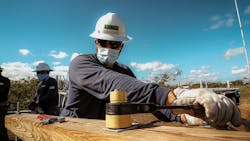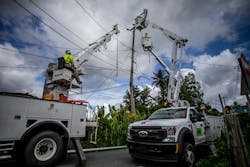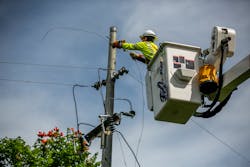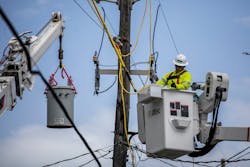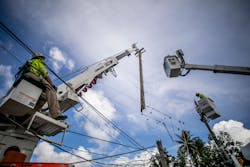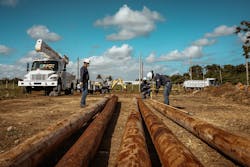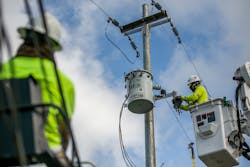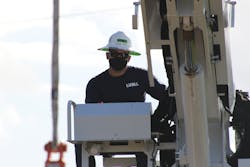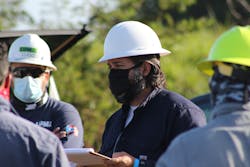Renewables Lay the Foundation for Puerto Rico’s Grid Rebuild
Hurricane Maria’s impact on Puerto Rico is hard to overstate. The lethal Category 5 hurricane in September 2017 was the deadliest storm of this millennium so far, and Puerto Rico bore the brunt of its impact.
Disruptions to electrical infrastructure often cascade into other critical infrastructure, creating a domino effect during emergencies. Puerto Rico experienced this in the aftermath of Maria, which hit the island just two weeks after Category 5 Hurricane Irma. The 10th most intense hurricane on record in the Atlantic, according to the National Oceanic and Atmospheric Administration (NOAA), Maria was a humanitarian catastrophe and severe blow to critical infrastructure in Puerto Rico. In a National Hurricane Center report on Hurricane Maria (AL152017) in February 2019, Maria’s damage to Puerto Rico was estimated at US$90 billion, making it the third costliest hurricane in U.S. history.
While the role of social vulnerability is inherently complex, it can be an important factor in the impacts power outages have on communities. The prolonged power outages after Maria had an especially harsh impact on those living with chronic medical conditions, according to “The Impact of Hurricane Maria on Individuals Living with Non-Communicable Disease in Puerto Rico: The Experience of 10 Communities,” a research article under consideration at BMC Public Health. Other vulnerable communities also generally were more affected. For example, those with higher rates of poverty among the elderly population and a higher proportion of Spanish-only speakers experienced longer restoration times. Although the economic damage from these prolonged power outages may be difficult to decouple from other effects of the storm, it had a detrimental impact on Puerto Rico, according to a climate policy brief on Puerto Rico, Climatic Extremes and the Economics of Resilience, published in December 2017 by the Global Development and Environment Institute at Tufts University.
LUMA Energy, LLC was selected through a competitive process established by law by the Puerto Rico Public-Private Partnerships Authority to transform the island’s electricity system. LUMA is owned by Canadian Utilities Ltd., an ATCO company, and Quanta Services. Taking over from the Puerto Rico Electric Power Authority (PREPA), LUMA entered into a T&D system operation and maintenance agreement in June 2020. Between then and the start of its operations on June 1, 2021, the utility performed a detailed assessment to identify gaps in planning, operations and procedures in Puerto Rico. Based on this assessment, LUMA has designed and submitted a comprehensive plan for improvement programs, budgets and operation principles as part of its transition.
Renewable Targets
With the growing impacts of climate change, the overall threat of future disruptions also continues to grow. This increased threat to electrical infrastructure signifies the importance of focusing on resilience and reliability in grid transformation, modernization and planning efforts. A resilient electric grid is a building block for integrating clean energy and advanced technologies. However, when planning reliability and resilience improvements, the needs and overall status of the region and grid must be considered. This is especially important for damaged infrastructure, such as Puerto Rico’s. A new approach like the use of microgrids demonstrated value to communities during widespread outages after a series of earthquakes hit the island in early 2020. Based on this experience, LUMA began developing a technical requirement and interconnection procedure for microgrids. The utility believes bringing microgrids and other innovations to scale is the next big step toward building its resilience.
Since Hurricane Maria, Puerto Rico has set ambitious renewable portfolio standard (RPS) targets. The Puerto Rico Energy Public Policy Act of 2019 established targets to achieve 40% renewable integration by 2025, 60% by 2040 and 100% by 2050. The act also targets for demand response and energy-efficiency programs as well as goals to facilitate the interconnection of distributed generation. Today, less than 5% of generation in Puerto Rico comes from renewables. In addition, the Puerto Rico Energy Bureau (PREB) has ongoing dockets on optimizing resilience investments in Puerto Rico.
Unique Challenges
The Puerto Rican electric grid’s performance was an ongoing issue prior to Hurricanes Irma and Maria, which ultimately led to PREPA filing for bankruptcy in July 2017. Reliability metrics before the hurricanes were below U.S. industry standards, with the trend worsening between 2014 and 2017. LUMA’s assess-
ment revealed issues in Puerto Rico were not limited to damage from the hurricanes; inadequate maintenance, aging infrastructure and operational issues also led to performance below industry standards.
Puerto Rico shares the unique challenges of an island electric system. This puts more emphasis on the need for a diverse set of resources, like utility-scale smart inverters, and grid investments to ensure redundancy.
Puerto Rico also has many challenges that impact its vulnerability when outages occur. More than 40% of the population lives below the poverty line. Additionally, approximately 15% of people under the age of 65 live with at least one disability. The overall population also has been declining, according to the 2019 U.S. Census. And, of course, it is an island and not immediately accessible to an adjacent state or region for assistance, whether for disaster assistance or electricity exchanges.
Reliability and Resilience
It is critical to bring Puerto Rico’s grid to a functioning state for improved reliability, resilience and public safety. A functional grid can be achieved by remediating, recovering and repairing infrastructure and assets in the highest risk areas. LUMA has developed a system remediation plan for this purpose, designing improvement programs such as rebuilding distribution lines and repairing and rebuilding damaged substations.
Stabilizing and restoring the electric grid through such improvement programs and investments is critical to transforming Puerto Rico’s energy system and enabling new technologies to provide customers access to cleaner sources of energy at reasonable prices. LUMA is taking a page from Hawaiian Electric, Maui Electric and Hawai’i Electric Light’s grid modernization strategy, which states: “Investing in advanced technologies overlaid on old, failing infrastructure is like putting a high-performance battery-electric drive system in a rusty 40-year-old car with flat tires.”
LUMA plans to move Puerto Rico’s 20th century grid to a 21st century grid, on par with industry standards and allowing an accelerated sustainable energy transformation to a resilient and renewable resource-leveraging grid. Addressing the highest risk areas to achieve the desired levels of reliability and resilience is part of a larger set of improvement programs LUMA has developed to recover and transform the grid. Recovery and transformation will not be approached independently, as they are highly interdependent. Using a diverse portfolio of resources, the utility’s overall objective is to accelerate transformation to a resilient and renewable resource, and advanced enabling technology leveraging grid.
Procedures, Processes and Systems
Improvements in Puerto Rico will not be limited to remediating the grid. As LUMA’s gap assessment revealed, sharpening operational procedures, processes and systems also are necessary. This includes streamlining interconnection processes, incorporating organized integrated resource and system planning functions, and implementing comprehensive planning functions such as enhanced load forecasting and system impact studies.
Digital transformation also is necessary, including updated telecommunications systems and networks, enhanced first-responder and emergency-response communication, improved resilience of the internal utility communications network, and visibility, monitoring and control over facilities and distributed energy resources (DERs). Updated networks will enable essential communication with the operation systems that monitor and manage distributed technologies, increasing visibility of these systems. This visibility is foundational to modern systems like energy management system (EMS), advanced distribution management systems (ADMS), advanced metering infrastructure (AMI), distributed energy resource management systems (DERMS). Visibility and control into distribution systems also are key to managing potential impacts from DERs, which can impact distribution equipment and power quality to customers. For example, LUMA’s EMS replacement program ultimately will provide the utility the required situational awareness it needs under increased penetration of renewables.
On the bulk system side of things, LUMA has developed system operation principles because communication protocols, operations and procedures — including system restoration and unplanned outage management procedures — need to be put in place to improve management and efficiency of generation dispatch, especially during emergencies. Given the different characteristics of renewables from conventional resources and subsequent changes to operations, increased visibility and situational awareness through EMS deployment is necessary to mitigate potential impacts and manage renewables. LUMA’s bulk system efforts include instituting standards for large-scale renewable interconnection and improving area generation control (AGC) capabilities.
Streamlined interconnection processes and requirements are essential for safe and agile integration of distributed and large-scale resources. LUMA’s ongoing efforts to streamline interconnection processes will be instrumental in accelerated integration of renewable resources. In Puerto Rico, smart inverter capabilities have not been used yet. LUMA recognizes the significant benefits of smart inverter capabilities and settings, aligned with standards such as IEEE 1547, in facilitating renewable energy integration and providing services such as voltage and frequency support with reliability and power quality benefits.
Puerto Rico will significantly benefit from collaboration with national laboratories. Several studies and ongoing efforts led by the U.S. Department of Energy (DOE) are specific to Puerto Rico, including studies on DER integration, recommendations on interconnection technical requirements and processes, and potential locations for microgrids. Partnerships with national labs and the DOE have been a priority for LUMA to leverage their expertise. In its path to renewables, Puerto Rico must incorporate learnings from other jurisdictions with high penetrations of renewables. Similar island systems to Puerto Rico, such as the state of Hawaii, can prove
to be useful to study, while recognizing Puerto Rico’s grid is currently below minimum standards.
Using emerging methods of analyzing vulnerabilities, including social vulnerability, through partnerships with national labs among others also will provide a more robust understanding and integration of non-engineering vulnerabilities that engineered processes are overlaid onto. Additional mechanisms for outreach and inclusion of community perspectives also are being explored to ensure vital voices are not lost in key investment decisions. The symphony of engineering that will make up the grid of the future has benefits to communities. A better understanding of these benefits and ultimately integrating that value into decisions will help to ensure not only grid resilience but also broader community resilience.
Looking Ahead
Most importantly, a functioning grid is foundational to enabling clean energy, and a modern grid is required to mitigate and adapt to the impacts of climate change. A comprehensive and holistic approach to planning — across resource, transmission and distribution functions — will enable LUMA to make better investment decisions, incorporate advanced non-wire alternatives, consider the value DERs provide and ensure community voices are heard throughout the planning process. This more robust and inclusive planning framework will benefit everyone in Puerto Rico.
Shay Bahramirad, PhD. is the vice president of Climate and Resilience at Quanta Technology. She advises LUMA. She is responsible for assisting cities and utilities with climate change risk assessments for their assets, operations, and services and for developing mitigation strategies and investment strategies for adapting to climate change. Bahramirad has held several positions in the energy sector, including vice president of Engineering and Smart Grid at ComEd. In these roles, she has overseen and/or executed “grid of the future” visions, technical roadmaps, analytical frameworks, and investment strategies of distribution system and communication network. She has also been responsible for system reliability, DER integration, grid strategy and analytics, standards, maintenance inspection, emerging technologies, STEM programming, and reimagining the power grid to mitigate and adapt to climate change. She has also developed talent strategies, industry engagement plans, and advocacy programs to support business objectives. She has been the expert witness and testified on several state and federal regulatory proceedings around microgrids, energy storage, investment strategies, and Distributed generation interconnection; 1547. Bahramirad is an editorial board member of the Electricity Journal, an adjunct professor at the Illinois Institute of Technology, and the IEEE/PES Vice President of New Initiatives and Outreach, overseeing the organization’s engagement with policymakers globally around technical issues, investment strategies, emerging technologies, and developing plans for the next generation of frameworks including smart cities, and clean energy. She is a contributor to the United Nations SG7, Affordable and Clean Energy. Bahramirad received her PhD degree in electrical engineering from Illinois Institute of Technology.
Mario Hurtado is chief regulatory officer for LUMA Energy where he provides leadership and oversight for regulatory policy, reporting and compliance for the public private partnership that operates Puerto Rico’s transmission and distribution system. Hurtado comes to this position from Quanta Services, where he was vice president Regulatory and part of the team that developed LUMA’s successful proposal to recover and transform the Puerto Rican electrical grid. He has over 25 years of experience in the electric utility, renewable energy and natural gas sectors. As co-founder and executive vice president of Clean Line Energy Partners, he led the development of a $2.5 billion transmission line to connect 4,000 MW of renewable energy produced in the Oklahoma Panhandle to utilities in the Southeast U.S. The journey to build renewable energy infrasructure by Clean Line and Mario’s business partner Michael Skelly are featured the book Superpower by Russell Gold (Simon & Shuster, 2019). Hurtado is fully English-Spanish bilingual, is fluent in Portuguese and proficient in French, and has led diverse teams across multiple countries. He received his Bachelor of Arts in Political Science from Columbia University and pursued his Master of Arts in International Relations with concentrations in International Economics and Latin American Studies at the Nitze School of Advanced International Studies, Johns Hopkins University.
Damir Novosel, PHD., is president and founder of Quanta Technology and advises LUMA. He also served as president of Quanta Energized Services. Previously, he was vice president of ABB Automation and president of KEMA T&D US. Novosel is a member the US National Academy of Engineers and served as president of the IEEE Power and Energy Society. He holds 17 US and international patents. Novosel received his PhD degree in electrical engineering from Mississippi State University, which recognized him as Distinguished Engineering Fellow.
About the Author
Shay Bahramirad
Shay Bahramirad is the vice president of Engineering and Smart Grid at ComEd, where she serves as a strategic business leader in Commonwealth Edison, the electric utility serving Northern Illinois including Chicago, holding executive responsibility for ComEd’s vision of the grid of the future as well as communities of the future, system reliability, engineering, and planning. She completed her PhD in electrical engineering at the Illinois Institute of Technology.
Mario Hurtado
Mario Hurtado is chief regulatory officer for LUMA Energy where he provides leadership and oversight for regulatory policy, reporting and compliance for the public private partnership that operates Puerto Rico’s transmission and distribution system. Mario comes to this position from Quanta Services, where he was Vice President Regulatory and part of the team that developed LUMA’s successful proposal to recover and transform the Puerto Rican electrical grid.
Mario has over 25 years of experience in the electric utility, renewable energy and natural gas sectors. As Co-Founder and Executive Vice President of Clean Line Energy Partners, he led the development of a $2.5 billion transmission line to connect 4,000 MW of renewable energy produced in the Oklahoma Panhandle to utilities in the Southeast U.S. The journey to build renewable energy infrasructure by Clean Line and Mario’s business partner Michael Skelly are featured the book Superpower by Russell Gold (Simon & Shuster, 2019).
While part of large corporate energy players such as Reliant Energy and Duke Energy as well as start-ups like Globeleq, Mario also led transactions, operations and development for a range of integrated electric utilities and power generators throughout Latin American and the Caribbean and several US states.
Mario is fully English-Spanish bilingual, is fluent in Portuguese and proficient in French, and has led diverse teams across multiple countries. He received his Bachelor of Arts in Political Science from Columbia University and pursued his Master of Arts in International Relations with concentrations in International Economics and Latin American Studies at the Nitze School of Advanced International Studies, Johns Hopkins University.
Damir Novosel
President
Damir Novosel (SM 1994, F 2003) is president of Quanta Technology, a subsidiary of Quanta Services. Previously, he was vice president of ABB Automation Products and president of KEMA T&D U.S. Damir was elected to National Academy of Engineers in 2014.
Dr. Novosel is IEEE PES President-Elect. He served as chair of the PES Technical Council, vice president of technology, and a member of the PES Governing Board from 2010 to 2012. Damir is also member of the CIGRE U.S. National Committee.
Damir holds 16 U.S. and international patents and published more than 100 articles in transactions, journals and proceedings, receiving PES 2011 and 2013 Prize Paper Awards. He has led or participated in numerous IEEE standards, publications and other initiatives, such as keynotes and panels.
Damir has been continuing contributor to education, including an adjunct professorship of Electrical Engineering at North Carolina State University, sponsorship of college scholarship programs, and support to industry courses and tutorials.
He holds PhD and MSc degrees in electrical engineering from Mississippi State University, where he was a Fulbright scholar, and the University of Zagreb, Croatia.
